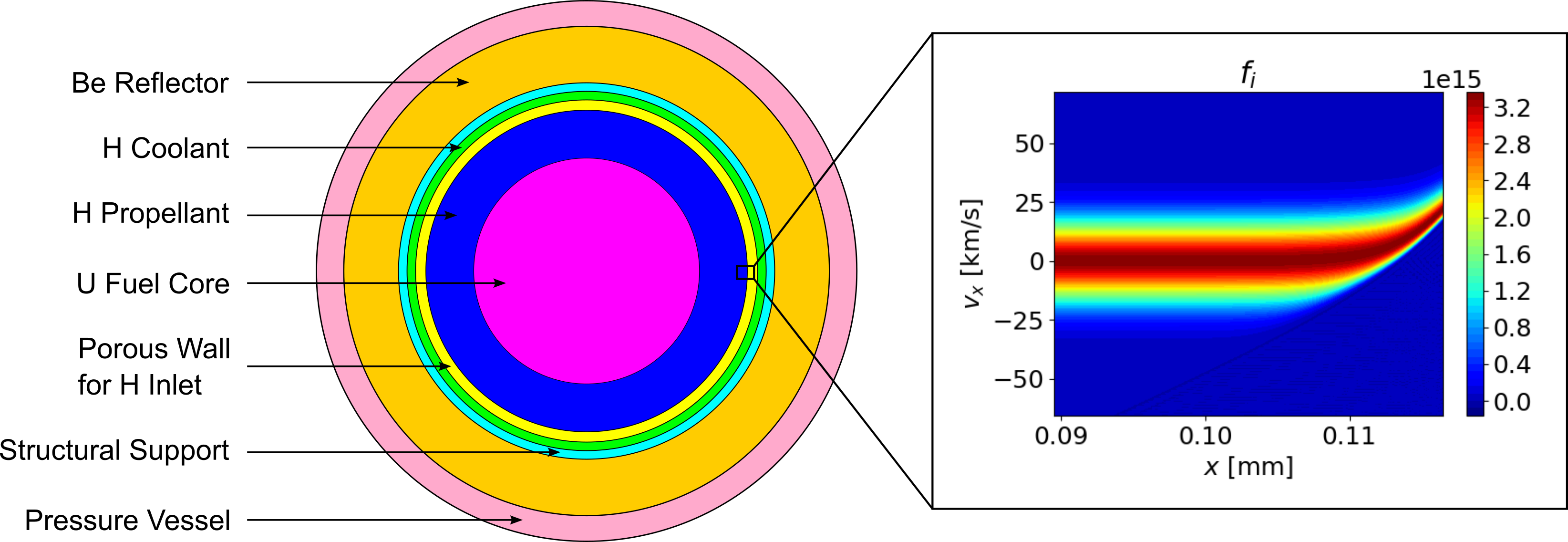Students
Kaela Kieler
Summary
In this project we are investigating the stability of a fissioning plasma in a gas core reactor (GCR), exploring materials that limit plasma erosion, and determining the heat transfer characteristics for the GCR.
In this spherical GCR model, the reactor is fueled by a stable uranium compound in a gaseous state at temperatures over 50,000 K. The uranium and hydrogen propellant are a homogeneous mixture. At such high temperatures, the gas becomes an ionized plasma, which allows for a closed loop magnetohydrodynamics (MHD) power cycle. The excess heat can be used to power single or multiple gas turbines and/or superheated steam cycles. The overall efficiency of the gas core reactor is over 60%, thus nearly twice as efficient as a conventional Light Water Reactor [1].
Benefits
G/VCR systems feature outstanding proliferation resistance characteristics and minimum vulnerability to external threats. These reactors produce plutonium two orders of magnitude less than Light Water Reactors (LWRs) [2]. In addition, the continuous transmutation and burning of actinides further reduces the quality of the fissile plutonium inventory [2]. The low fuel inventory, combined with continuous burning of actinides significantly reduces overall safety risk.
Challenges
- Stable confinement of the fissioning plasma.
- Minimization of uranium plasma erosion on surrounding materials.
- Heat transfer optimization from fissioning plasma to the hydrogen fuel.
- Reduction of fuel loss.
- Ability to simulate 3-D radiative heat transfer, neutron transport, and plasma transport.

Figure 1: Cavity GCR MCNP model (left), ion distribution function near a material boundary displaying a plasma sheath (right).
Computational Modeling
The nuclear data processing code NJOY21 was used to generate the various cross-section A Compact ENDF (ACE) libraries for all GCR model materials at temperatures ranging from 1,200 K to 55,000 K. Monte Carlo N-Particle (MCNP) radiation transport code was then used to generate the neutron particle tracking data and collision physics interactions inside the GCR model in Figure 1. The plasma physics code, Gkeyll, will be coupled with MCNP to provide and accurate heat transfer profile from the fissioning plasma to the pressure vessel.
Current Accomplishments
- A spherical GCR design was selected as an initial model to simplify modeling, heat transfer analysis and coupling of analysis codes.
- Initial model development using MCNP 6.3 and MCNP X Visual Editor
- Custom high temperature neutron cross section libraries for U-233 and U-235 using NJOY generated.
- Spherical MCNP gas core reactor model developed and produced critical reactor core with U-235 and U-233 using custom cross section libraries.
- Initial Gkeyll model of first wall ion distribution developed.
Future Work
- Refining MCNP gas core reactor model and source determination for input into Gkeyll.
- Continued development of Gkeyll model based on source term determined by MCNP.
- Coupling of MCNP model to Gkeyll model.
- Develop a one-dimensional heat transfer model of the spherical reactor and update custom cross section based on new temperature distribution.
- Determination of potential structural materials that can
Support
This project was made possible in part by a grant from The John Hauck Foundation, Fifth Third Bank and John W. Hauck, Co-Trustees. The views expressed herein do not necessarily represent those of The John Hauck Foundation, Fifth Third Bank and John W. Hauck, Co-Trustees.
References
[1] Y. Zhang, “Advanced nuclear power engine: A brief overview of gas core reactor for space exploration,” National Research University (Moscow Power Engineering Institute), 2023.
[2] S. Anghaie, T. W. Knight, R. Norring, and B. M. Smith, “Optimum utilization of nuclear fuel with gas and vapore core reactors,” Progress in Nuclear Energy, vol. 47, no. 1-4, pp. 74–90, 2005.
[3] R. S. Raju, Beyond the Solid Core Nuclear Thermal Rocket: A Computational Investigation into Criticality and Neutronics Performance of Advanced Liquid and Gas Core Reactor Approaches for Next Generation Performance. PhD thesis, University of Michigan, 2022.